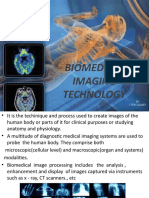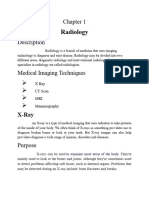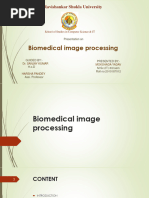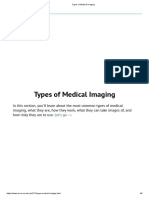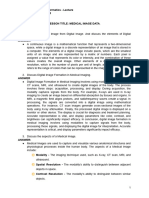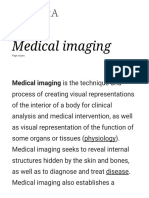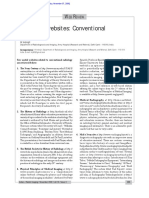ML_MedicalIMages
ML_MedicalIMages
Uploaded by
anipri2009Copyright:
Available Formats
ML_MedicalIMages
ML_MedicalIMages
Uploaded by
anipri2009Copyright
Available Formats
Share this document
Did you find this document useful?
Is this content inappropriate?
Copyright:
Available Formats
ML_MedicalIMages
ML_MedicalIMages
Uploaded by
anipri2009Copyright:
Available Formats
Medical imaging involves the use of various techniques to create visual representations of the
interior of the body for clinical analysis, diagnosis, and treatment planning. These images are
essential tools in modern medicine and are analyzed manually or using advanced tools like
Artificial Intelligence (AI) for enhanced accuracy.
Common Types of Medical Imaging Techniques:
1. X-rays:
o Description: A form of electromagnetic radiation used to view bones, chest
structures, and soft tissues.
o Applications: Detecting fractures, infections, lung diseases (e.g., pneumonia), and
dental issues.
2. Computed Tomography (CT) Scans:
o Description: Uses multiple X-ray images taken from different angles to create cross-
sectional images (slices) of the body.
o Applications: Diagnosing cancer, cardiovascular diseases, trauma, and internal
bleeding.
3. Magnetic Resonance Imaging (MRI):
o Description: Uses strong magnetic fields and radio waves to create detailed images
of soft tissues and organs.
o Applications: Brain imaging, musculoskeletal injuries, and detecting tumors.
4. Ultrasound (Sonography):
o Description: Uses high-frequency sound waves to produce real-time images of
internal structures.
o Applications: Monitoring fetal development, examining organs (e.g., liver, kidneys),
and guiding biopsies.
5. Positron Emission Tomography (PET) Scans:
o Description: A nuclear medicine imaging technique that uses a radioactive tracer to
visualize metabolic processes.
o Applications: Detecting cancer, heart diseases, and brain disorders.
6. Mammography:
o Description: A specialized X-ray technique used for breast imaging.
o Applications: Early detection of breast cancer.
7. Fluoroscopy:
o Description: Provides real-time X-ray imaging to observe internal movements, such
as blood flow or organ function.
o Applications: Used in guiding catheter insertions or assessing gastrointestinal
functions.
8. Nuclear Medicine Imaging:
o Description: Uses small amounts of radioactive materials to diagnose or treat
diseases.
o Applications: Diagnosing bone diseases, thyroid disorders, and heart conditions.
Role of AI in Medical Imaging:
AI plays a transformative role in medical imaging by enhancing accuracy, efficiency, and
diagnostics:
Image Analysis: AI algorithms can detect anomalies such as tumors, fractures, or infections
with high precision.
Pattern Recognition: Tools like deep learning analyze patterns in images, aiding early
diagnosis of diseases like cancer and Alzheimer's.
Workflow Automation: AI streamlines the imaging workflow, including image acquisition,
segmentation, and reporting.
Personalized Treatment: AI enables precise imaging-based assessments for tailored
therapies.
Medical images are pivotal in healthcare for diagnostics and treatment, and advancements in
imaging technology and AI integration are continuously improving patient outcomes.
You might also like
- Vascular Access Society of India (VASI) - Members ListDocument10 pagesVascular Access Society of India (VASI) - Members ListKriti KumariNo ratings yet
- Project Work Dnhe 04 Ignou by Dt. Puneet KumarDocument75 pagesProject Work Dnhe 04 Ignou by Dt. Puneet KumarPuneet Kumar100% (2)
- Bio Physics AssignmentDocument8 pagesBio Physics AssignmentAli InamNo ratings yet
- Imaging Modalities in RadiologyDocument44 pagesImaging Modalities in Radiologyazimatun nikmah100% (1)
- Scope of Diagnostic Imaging in Veterinary PracticeDocument9 pagesScope of Diagnostic Imaging in Veterinary PracticeAbdul RehmanNo ratings yet
- Anthropometric SDocument5 pagesAnthropometric SKoryne Escauriaga PangilinanNo ratings yet
- AI Techniques_CoronaDocument3 pagesAI Techniques_Coronaanipri2009No ratings yet
- Biomedical Unit - 2 - ImagingDocument13 pagesBiomedical Unit - 2 - ImagingShravani HoreNo ratings yet
- TechnicalDocument20 pagesTechnicalArun KNo ratings yet
- Biomedical Imaging Technology: BY 17RH1A04E1Document10 pagesBiomedical Imaging Technology: BY 17RH1A04E1Gagana ChowdaryNo ratings yet
- bmeDocument3 pagesbmesaiganeshchatharasupalliNo ratings yet
- What Is Medical Equipment and Types of Medical EquipmentDocument5 pagesWhat Is Medical Equipment and Types of Medical EquipmentNor Hassan AmbaNo ratings yet
- Biomedical Image AnalysisDocument6 pagesBiomedical Image Analysisrahuldantewadia181No ratings yet
- BiophysicsDocument9 pagesBiophysicshazharomar958No ratings yet
- Diagnostic Imaging Procedures - SFDocument33 pagesDiagnostic Imaging Procedures - SFSusan FNo ratings yet
- Artificial Intelligence_in_RoboticsDocument2 pagesArtificial Intelligence_in_Roboticsxicayoj560No ratings yet
- Intro To Medical ImagingDocument25 pagesIntro To Medical ImagingrajakaniNo ratings yet
- BME-417L - PET ScanDocument5 pagesBME-417L - PET Scansarmadmukhtar21No ratings yet
- Medical ImagingDocument16 pagesMedical ImagingBoobalan RNo ratings yet
- Biomedical Image ProcessingDocument15 pagesBiomedical Image ProcessingMokshada YadavNo ratings yet
- Diagnostic ImagingDocument25 pagesDiagnostic Imagingprakritibhatnagar1511No ratings yet
- Diagnostic ImagingDocument25 pagesDiagnostic Imagingprakritibhatnagar1511No ratings yet
- TRABAJO CRITERIO D-FDocument8 pagesTRABAJO CRITERIO D-F4tcjdvdfryNo ratings yet
- Medical Imaging 2Document32 pagesMedical Imaging 2ETINGE SAKWE MOUKOUNDI PRINCEWILNo ratings yet
- IMAGING BMIDocument12 pagesIMAGING BMIAbhishek GuptaNo ratings yet
- Medical Imaging Is The Technique and Process Used To CreateDocument11 pagesMedical Imaging Is The Technique and Process Used To Creates.reeganNo ratings yet
- AI Techniques in MedicineDocument2 pagesAI Techniques in Medicineanipri2009No ratings yet
- ReportDocument10 pagesReportMugesh KannanNo ratings yet
- Neurology Summary For PTDocument20 pagesNeurology Summary For PTAriel ShermanNo ratings yet
- Radiology Intro 2Document31 pagesRadiology Intro 2Aqee FarooqNo ratings yet
- Assignment On CT, MRI, EEGDocument14 pagesAssignment On CT, MRI, EEGManisha Samson100% (3)
- Biomedical Image ProcessingDocument26 pagesBiomedical Image ProcessingMokshada YadavNo ratings yet
- Medical ImagingDocument8 pagesMedical ImagingMansourNo ratings yet
- Diagnostic Medical ImagingDocument8 pagesDiagnostic Medical ImagingSusan FNo ratings yet
- Assignment # 1: Hanya Khan, Habiba RiazDocument10 pagesAssignment # 1: Hanya Khan, Habiba RiazFaisal AwanNo ratings yet
- 0 Intro To RTDocument16 pages0 Intro To RTjsdeleonNo ratings yet
- Hazim Kamal Alden Ahmed Elbagir.: U.M.S.T Master Biomedical Engineering: DR - SaraDocument6 pagesHazim Kamal Alden Ahmed Elbagir.: U.M.S.T Master Biomedical Engineering: DR - SaraHazimkamalNo ratings yet
- Lecture#1 1Document10 pagesLecture#1 1Afsheen ZaibNo ratings yet
- 20/7007 Rahul Yadav xray practicalDocument6 pages20/7007 Rahul Yadav xray practicaljaydeemeh67.6No ratings yet
- Diagnostic TechniquesDocument12 pagesDiagnostic Techniquesdoctorstrange6427No ratings yet
- RT 004 LEC 3Document4 pagesRT 004 LEC 3Tia RoseNo ratings yet
- Medical Imaging: Such As CAT Scans and MRIDocument11 pagesMedical Imaging: Such As CAT Scans and MRINeco Carlo PalNo ratings yet
- RadiologyDocument3 pagesRadiologynagarkaraditya2747No ratings yet
- Scanning TechDocument9 pagesScanning Techabhijiths64095No ratings yet
- Fact Sheet Magnetic Resonance Imaging MRIDocument2 pagesFact Sheet Magnetic Resonance Imaging MRIsunlianzhuNo ratings yet
- University of The Cordilleras College of Nursing: Computed Tomography (CT) ScanDocument7 pagesUniversity of The Cordilleras College of Nursing: Computed Tomography (CT) ScanCarrie Joy DecalanNo ratings yet
- Gamma CameraDocument26 pagesGamma CameraNishtha TanejaNo ratings yet
- Project Parallel ComputingDocument9 pagesProject Parallel ComputingEng-Mushtaq HejairaNo ratings yet
- Penerapan Citra Medik Pada Visualisasi Pencitraan Diagnostik Tumor Otak Secara Sagittal Mengunakan Magnetic Resonance Imaging (Mri)Document6 pagesPenerapan Citra Medik Pada Visualisasi Pencitraan Diagnostik Tumor Otak Secara Sagittal Mengunakan Magnetic Resonance Imaging (Mri)alexia efilindaNo ratings yet
- XRAYSDocument10 pagesXRAYSkeeratkbediNo ratings yet
- Magnetic Resonance ImagingDocument1 pageMagnetic Resonance ImagingmbarsaiyanNo ratings yet
- Neuroimaging TechniquesDocument9 pagesNeuroimaging Techniqueslawrence agbortabiNo ratings yet
- Current Diagnostic Techniques in Veterinary Surgery PDFDocument2 pagesCurrent Diagnostic Techniques in Veterinary Surgery PDFKirti JamwalNo ratings yet
- Medical ImagingDocument93 pagesMedical ImagingpraveenNo ratings yet
- Radiologists: Chronicle Guidance Publications Brief 462Document4 pagesRadiologists: Chronicle Guidance Publications Brief 462Madison DahseNo ratings yet
- Types of ScanPSY105Document2 pagesTypes of ScanPSY105h_brandonNo ratings yet
- BraintumorDocument5 pagesBraintumorradiologirsslametriyadiNo ratings yet
- Optical Imaging Fact SheetDocument2 pagesOptical Imaging Fact SheetFeby Shyntia AfirantiNo ratings yet
- Emergency Radiology: The Basics: Rathachai Kaewlai, MDDocument41 pagesEmergency Radiology: The Basics: Rathachai Kaewlai, MDsafitrie_liaNo ratings yet
- Name - Reel Abdelsamad HassanDocument3 pagesName - Reel Abdelsamad HassanreelabdelsamadhassanNo ratings yet
- Radiology Notes (1-36)Document83 pagesRadiology Notes (1-36)el spin artifactNo ratings yet
- Diagnostic Techniques (MRI, USG, CT Scan)Document43 pagesDiagnostic Techniques (MRI, USG, CT Scan)Snehal SinghNo ratings yet
- Conventional RadiologyDocument2 pagesConventional RadiologyPier Cedron LescanoNo ratings yet
- Nutrition Care ProcessDocument78 pagesNutrition Care ProcessMaureen CuartoNo ratings yet
- Sample Resume For Radiologic TechnologistDocument7 pagesSample Resume For Radiologic Technologistktrplormd100% (1)
- Anthropometric DataDocument8 pagesAnthropometric DataMaimai Rea CondeNo ratings yet
- Pixium RF - 4343 - ENDocument2 pagesPixium RF - 4343 - ENlorisaszigiNo ratings yet
- Resort Literature Case StudyDocument2 pagesResort Literature Case StudyChristian DaivaNo ratings yet
- ProfileDocument3 pagesProfilesainiamanpreetNo ratings yet
- Bmi Monitoring SheetDocument13 pagesBmi Monitoring SheetMaricel Ang BajeyoNo ratings yet
- Ergonomics of Car Packaging Part 1Document2 pagesErgonomics of Car Packaging Part 1Ejan AdinNo ratings yet
- RadiographyDocument121 pagesRadiographyzano_adam100% (1)
- Do You Know What Your Bmi Is?: Body Mass Index (BMI) Is One Indicator of Healthy or Unhealthy WeightDocument1 pageDo You Know What Your Bmi Is?: Body Mass Index (BMI) Is One Indicator of Healthy or Unhealthy Weightbooklover20No ratings yet
- Government of India Atomic Energy Regulatory Board Radiological Safety Division (RSD)Document4 pagesGovernment of India Atomic Energy Regulatory Board Radiological Safety Division (RSD)Sathish ChelliahNo ratings yet
- Visitacion Act 1 Tdee Stats ReportDocument3 pagesVisitacion Act 1 Tdee Stats ReportHannah VisitacionNo ratings yet
- Resume of MonirDocument6 pagesResume of Monirmhossaink8856No ratings yet
- School Form 8 (SF 8)Document2 pagesSchool Form 8 (SF 8)Geraldo N. QuillaoNo ratings yet
- TricycleDocument10 pagesTricyclechancer01No ratings yet
- SOPDocument3 pagesSOPDrehsan MemonNo ratings yet
- Flyer Dari SiemensDocument8 pagesFlyer Dari SiemenszmichelleangelinaNo ratings yet
- Inventory Number/ Serial Number EquipmentDocument3 pagesInventory Number/ Serial Number EquipmentWebster The-TechGuy LunguNo ratings yet
- Physical Education Practical 5Document9 pagesPhysical Education Practical 5Ishita SinghNo ratings yet
- PRICE LIST AKD AKL With TKDN-NEW VersionDocument7 pagesPRICE LIST AKD AKL With TKDN-NEW VersionwisnubernofarmNo ratings yet
- EMEA - PRO-S - EB19-J10U Factsheet - 09.2017Document2 pagesEMEA - PRO-S - EB19-J10U Factsheet - 09.2017melloukiNo ratings yet
- FAMPDocument27 pagesFAMPChandra SekharNo ratings yet
- Master List Beneficiaries For School-Based Feeding Program (SBFP)Document12 pagesMaster List Beneficiaries For School-Based Feeding Program (SBFP)Elvin Manjares100% (1)
- Four Hour Body Experiment Tracker TemplateDocument4 pagesFour Hour Body Experiment Tracker Templatechanellekristyweaver100% (1)
- BMFP3553 Industrial ErgonomicsDocument7 pagesBMFP3553 Industrial Ergonomicsann manipalNo ratings yet
- Anthropometry MeasurementDocument9 pagesAnthropometry MeasurementMD Al-AminNo ratings yet









